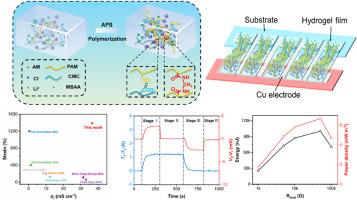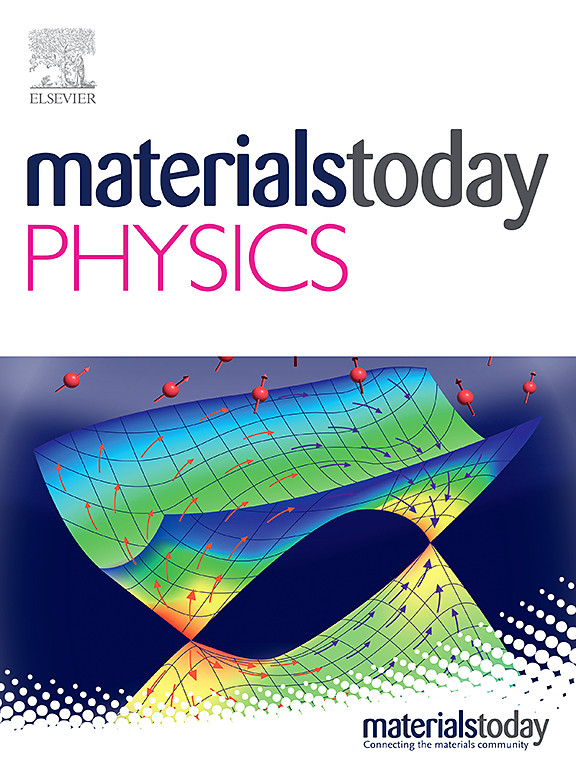Highly stretchable, low-hysteresis, and antifreeze hydrogel for low-grade thermal energy harvesting in ionic thermoelectric Supercapacitors
IF 10
2区 材料科学
Q1 MATERIALS SCIENCE, MULTIDISCIPLINARY
引用次数: 0
Abstract
Efficient harvest of low-grade waste heat in the environment through thermoelectric materials represents a promising strategy to address the current energy crisis. In practical applications, the mechanical properties of thermoelectric materials are crucial for their lifespan and operational environment. In this study, we designed a series of ionic thermoelectric hydrogels, PAM/CMC-xLiCl, with high mechanical properties. These hydrogels are formed by a dual network structure composed of polyacrylamide (PAM) and sodium carboxymethyl cellulose (CMC), with LiCl serving as the conductive material. At room temperature, the optimal Seebeck coefficient and ionic conductivity of the hydrogels can reach 2.96 mV K−1 and 36.51 mS cm−1, respectively. Based on the physical entanglement, hydrogen bonding, and chemical crosslinking of the polymer chains within the ionic hydrogels, which demonstrate outstanding mechanical properties (elongation at break >1300 %, fracture toughness >1700 kJ m−3), maintaining 95 % resilience under a large strain of 400 %. Furthermore, due to the hydration properties of LiCl, the ionic hydrogels exhibit excellent freeze resistance and the capability to absorb moisture for self-regeneration upon drying. Lastly, the fabricated ionic thermoelectric supercapacitor can generate a thermoelectric voltage of 0.182 V under a ΔT of 12 K, with a power density of 6.68 mW m−2, showing promising prospects for application in waste heat harvest fields.


用于离子热电超级电容器中低级热能收集的高拉伸、低滞后和抗冻水凝胶
通过热电材料有效收集环境中的低品位废热,是解决当前能源危机的一项大有可为的战略。在实际应用中,热电材料的机械性能对其寿命和运行环境至关重要。在本研究中,我们设计了一系列具有高机械性能的离子热电水凝胶 PAM/CMC-xLiCl。这些水凝胶由聚丙烯酰胺(PAM)和羧甲基纤维素钠(CMC)组成的双重网络结构构成,并以氯化锂作为导电材料。室温下,水凝胶的最佳塞贝克系数和离子电导率分别可达 2.96 mV K-1 和 36.51 mS cm-1。基于离子水凝胶中聚合物链的物理缠结、氢键和化学交联,该水凝胶具有出色的机械性能(断裂伸长率为 1300%,断裂韧性为 1700 kJ m-3),在 400% 的大应变下仍能保持 95% 的回弹性。此外,由于氯化锂的水合特性,离子水凝胶表现出卓越的抗冻性和吸湿能力,可在干燥后自我再生。最后,所制备的离子热电超级电容器在 12 K 的 ΔT 下可产生 0.182 V 的热电电压,功率密度为 6.68 mW m-2,在余热收集领域的应用前景十分广阔。
本文章由计算机程序翻译,如有差异,请以英文原文为准。
求助全文
约1分钟内获得全文
求助全文
来源期刊

Materials Today Physics
Materials Science-General Materials Science
CiteScore
14.00
自引率
7.80%
发文量
284
审稿时长
15 days
期刊介绍:
Materials Today Physics is a multi-disciplinary journal focused on the physics of materials, encompassing both the physical properties and materials synthesis. Operating at the interface of physics and materials science, this journal covers one of the largest and most dynamic fields within physical science. The forefront research in materials physics is driving advancements in new materials, uncovering new physics, and fostering novel applications at an unprecedented pace.
 求助内容:
求助内容: 应助结果提醒方式:
应助结果提醒方式:


